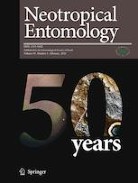View Item
- xmlui.general.dspace_homeCentros Regionales y EEAsCentro Regional Patagonia NorteEEA BarilocheArtículos científicosxmlui.ArtifactBrowser.ItemViewer.trail
- DSpace Home
- Centros Regionales y EEAs
- Centro Regional Patagonia Norte
- EEA Bariloche
- Artículos científicos
- View Item
Distribution, Invasion History, and Ecology of Non-native Pine Bark Beetles (Coleoptera: Curculionidae: Scolytinae) in Southern South America
Abstract
The growth of international trade, coupled with an expansion of large-scale pine plantations in South America during the second half of the twentieth century, has significantly increased the opportunities for the invasion of forest insects. Bark beetles (Coleoptera: Curculionidae, Scolytinae) are a large and diverse group of insects, commonly recognized as one of the most important tree mortality agents in coniferous forests worldwide and an important
[ver mas...]
The growth of international trade, coupled with an expansion of large-scale pine plantations in South America during the second half of the twentieth century, has significantly increased the opportunities for the invasion of forest insects. Bark beetles (Coleoptera: Curculionidae, Scolytinae) are a large and diverse group of insects, commonly recognized as one of the most important tree mortality agents in coniferous forests worldwide and an important group among invasive forest species. In this study, we combined data from field sampling with published records of established non-native pine bark beetles, to describe their distribution and invasion history in pine plantations across southern South America, reviewing the available information on their phenology and host range. We obtained records of established populations of six Eurasian species distributed in two major regions: the southwest region comprises plantations in Chile and the Argentine Patagonia, with four bark beetle species: Hylastes ater, Hylastes linearis, Hylurgus ligniperda, and Orthotomicus laricis; the northeastern zone includes northeastern Argentina, Uruguay, and southern Brazil, and includes three bark beetle species: Cyrtogenius luteus, H. ligniperda, and O. erosus. The establishment of non-native populations across the study area began in the 1950s, and from the 1980s onwards, there has been an exponential increase in introductions. We predict that several of these species will continue spreading across South America and that new species will continue arriving. We highlight the importance of international collaboration for early detection and management of non-native pine bark beetles.
[Cerrar]

Author
Lantschner, Maria Victoria;
Gomez, Demian F.;
Vilardo, Gimena;
Stazione, Leonel Daniel;
Ramos, Sergio Orlando;
Eskiviski, Edgar Rafael;
Fachinetti, Romina;
Schiappacassi, Marcela;
Vallejos, Natalia;
Germano, Monica Daniela;
Villacide, Jose Maria;
Grilli, Mariano P.;
Martinez, Gonzalo;
Ahumada, Rodrigo;
Estay, Sergio A.;
Dumois, Ignacio;
Corley, Juan Carlos;
Fuente
Neotropical Entomology : 1-13 (Published: 18 January 2024)
Date
2024-01
Editorial
Springer
ISSN
1678-8052
Formato
pdf
Tipo de documento
artículo
Palabras Claves
Derechos de acceso
Restringido
 Excepto donde se diga explicitamente, este item se publica bajo la siguiente descripción: Creative Commons Attribution-NonCommercial-ShareAlike 2.5 Unported (CC BY-NC-SA 2.5)
Excepto donde se diga explicitamente, este item se publica bajo la siguiente descripción: Creative Commons Attribution-NonCommercial-ShareAlike 2.5 Unported (CC BY-NC-SA 2.5)


